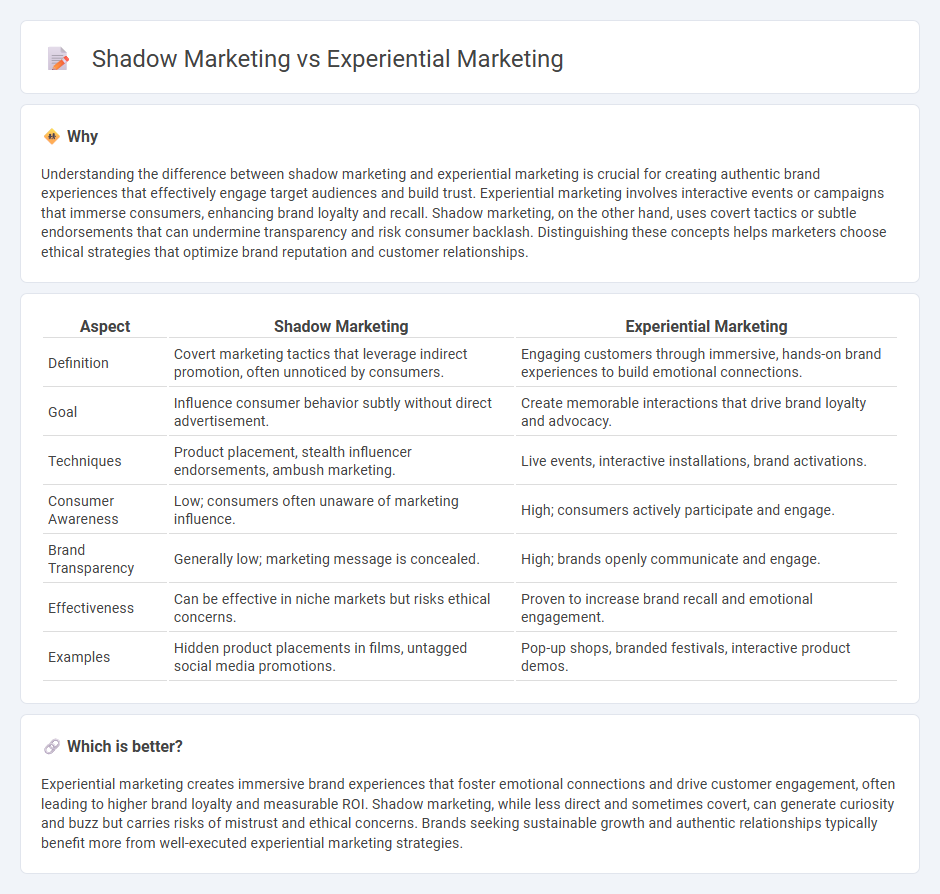
Shadow marketing operates by influencing consumer behavior through subtle, indirect strategies often leveraging social media and influencer tactics, creating organic brand awareness without overt promotion. Experiential marketing engages customers directly through immersive, sensory experiences that foster emotional connections and memorable interactions with the brand. Discover how these innovative marketing approaches can redefine your brand strategy and drive deeper consumer engagement.
Why it is important
Understanding the difference between shadow marketing and experiential marketing is crucial for creating authentic brand experiences that effectively engage target audiences and build trust. Experiential marketing involves interactive events or campaigns that immerse consumers, enhancing brand loyalty and recall. Shadow marketing, on the other hand, uses covert tactics or subtle endorsements that can undermine transparency and risk consumer backlash. Distinguishing these concepts helps marketers choose ethical strategies that optimize brand reputation and customer relationships.
Comparison Table
| Aspect | Shadow Marketing | Experiential Marketing |
|---|---|---|
| Definition | Covert marketing tactics that leverage indirect promotion, often unnoticed by consumers. | Engaging customers through immersive, hands-on brand experiences to build emotional connections. |
| Goal | Influence consumer behavior subtly without direct advertisement. | Create memorable interactions that drive brand loyalty and advocacy. |
| Techniques | Product placement, stealth influencer endorsements, ambush marketing. | Live events, interactive installations, brand activations. |
| Consumer Awareness | Low; consumers often unaware of marketing influence. | High; consumers actively participate and engage. |
| Brand Transparency | Generally low; marketing message is concealed. | High; brands openly communicate and engage. |
| Effectiveness | Can be effective in niche markets but risks ethical concerns. | Proven to increase brand recall and emotional engagement. |
| Examples | Hidden product placements in films, untagged social media promotions. | Pop-up shops, branded festivals, interactive product demos. |
Which is better?
Experiential marketing creates immersive brand experiences that foster emotional connections and drive customer engagement, often leading to higher brand loyalty and measurable ROI. Shadow marketing, while less direct and sometimes covert, can generate curiosity and buzz but carries risks of mistrust and ethical concerns. Brands seeking sustainable growth and authentic relationships typically benefit more from well-executed experiential marketing strategies.
Connection
Shadow marketing leverages subtle, often covert promotional tactics to influence consumer behavior without overt advertisement, closely aligning with experiential marketing's focus on immersive, sensory brand experiences. Both strategies prioritize authentic engagement, enhancing brand perception by creating memorable interactions that resonate on a personal level. This connection enables brands to seamlessly integrate promotional efforts into real-life experiences, driving deeper emotional connections and customer loyalty.
Key Terms
Experiential marketing:
Experiential marketing leverages immersive, hands-on brand interactions to create memorable customer experiences that drive emotional engagement and brand loyalty. By incorporating sensory elements, interactive events, and real-time feedback, it enhances consumer perception and boosts word-of-mouth promotion. Explore how experiential marketing strategies can transform your brand's connection with its audience.
Brand Engagement
Experiential marketing creates immersive brand experiences that actively engage consumers through interactive events, sensory stimuli, and personalized interactions, resulting in stronger emotional connections and higher brand recall. Shadow marketing operates through covert or subtle brand communications, leveraging influencer endorsements, user-generated content, and word-of-mouth to build organic trust and authenticity without direct promotional efforts. Explore detailed strategies to harness both experiential and shadow marketing for maximizing impactful brand engagement.
Immersive Events
Experiential marketing uses immersive events to engage consumers through interactive brand experiences, creating emotional connections that drive loyalty and sales. Shadow marketing leverages subtle, indirect tactics such as covert brand placements within these events to influence consumer behavior without overt promotion. Explore how immersive events blend both strategies to maximize impact and audience engagement.
Source and External Links
Experiential Marketing: A Guide - Salesforce - Experiential marketing creates immersive, memorable brand experiences that engage customers deeply through activities and events, often combining with traditional marketing for broader reach and interaction.
What is experiential marketing? Definition and examples - Amazon Advertising - Experiential marketing involves connecting brands and consumers through interactive experiences like pop-ups or virtual events, emphasizing memorable, on-brand, and measurable engagement.
What is experiential marketing: Definition, why it works & examples - Xola - Experiential marketing builds authentic emotional connections by offering sensory and interactive experiences that enhance brand perception, increase engagement, and deliver higher ROI than static ads.
 dowidth.com
dowidth.com